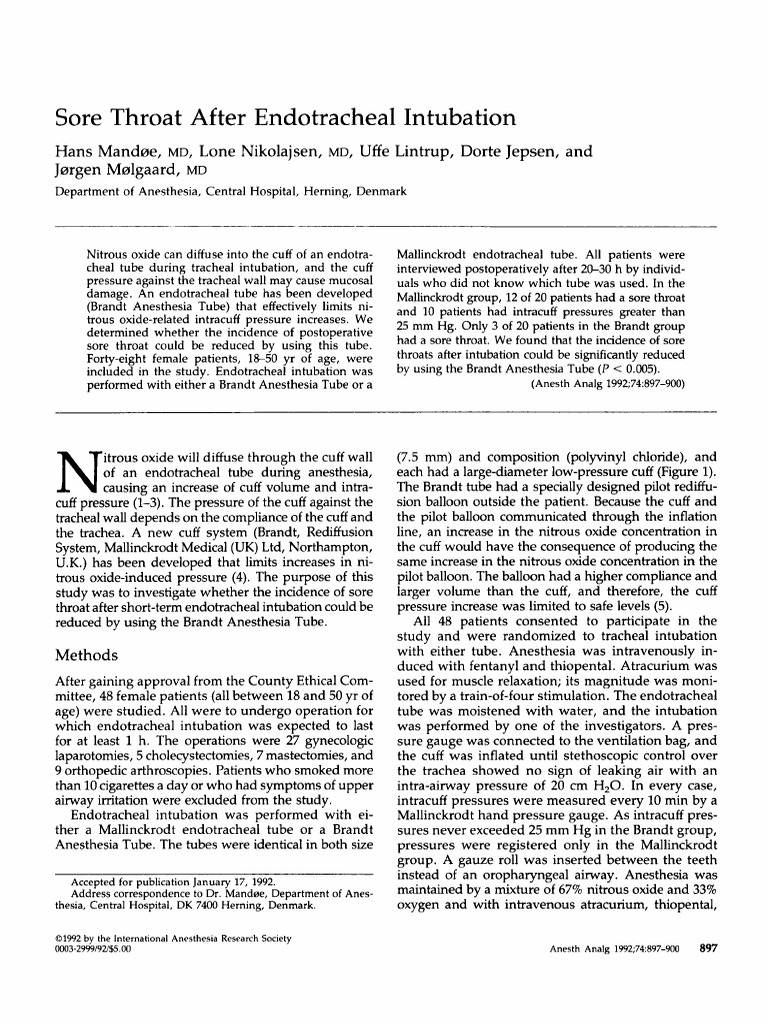Sore Throat After Anesthesia

A sore throat after anesthesia is a common complication that affects a significant number of patients who undergo surgical procedures. The condition, also known as postoperative sore throat (POST), can range from mild discomfort to severe pain, and its duration can vary from a few hours to several days. Understanding the causes, risk factors, and management strategies for POST is essential for minimizing its impact on patients’ recovery and quality of life.
The etiology of POST is multifactorial, involving various mechanisms related to the anesthesia process itself, the surgical procedure, and patient-specific factors. One of the primary causes of POST is the insertion of an endotracheal tube (ETT), which is a crucial component of general anesthesia. The ETT can cause irritation and trauma to the mucous membranes and tissues of the throat, leading to inflammation and discomfort. The duration of intubation, the size of the ETT, and the technique used for insertion are all factors that can influence the risk of developing POST.
Another significant contributor to POST is the use of a laryngeal mask airway (LMA), which, although less invasive than an ETT, can still cause irritation and discomfort in the throat. The positioning of the patient during surgery, particularly in procedures that require significant extension or flexion of the neck, can also contribute to the development of POST. Additionally, the type of anesthesia used, the use of succinylcholine for muscle relaxation, and the presence of pre-existing conditions such as gastroesophageal reflux disease (GERD) can all play a role in the onset and severity of POST.
The risk factors for POST can be broadly categorized into patient-related, procedure-related, and anesthesia-related factors. Patient-related factors include age, with older adults being at a higher risk, gender, with females being more susceptible, and the presence of pre-existing medical conditions such as GERD or a history of smoking. Procedure-related factors encompass the type and duration of the surgical procedure, the position of the patient during surgery, and the use of certain surgical instruments that may cause throat irritation. Anesthesia-related factors include the type of anesthesia used, the technique of intubation, and the use of certain anesthetic agents or adjuncts.
Research has shown that the incidence of POST can be significantly reduced through the implementation of evidence-based practices. These include the use of smaller diameter endotracheal tubes, the application of topical anesthesia to the throat before intubation, and the administration of anti-inflammatory medications postoperatively.
The management of POST involves a combination of pharmacological and non-pharmacological strategies. Pharmacological interventions include the use of analgesics, anti-inflammatory agents, and topical anesthetics. Non-pharmacological strategies encompass measures such as hydration, voice rest, and throat lozenges. The choice of management strategy depends on the severity of the sore throat, the presence of underlying conditions, and the patient’s overall health status.
In addition to these interventions, several preventive measures can be taken to minimize the risk of POST. These include meticulous attention to the technique of intubation, the use of a laryngeal mask airway when appropriate, and the administration of prophylactic anti-inflammatory medications. Patient education on the risks and management of POST is also crucial, as it enables patients to recognize the symptoms early and seek appropriate care.
Comparative Analysis of Intubation Techniques

A comparative analysis of different intubation techniques reveals that the risk of POST can be significantly influenced by the choice of technique. The traditional method of intubation using a Macintosh blade is associated with a higher risk of POST compared to the use of a GlideScope or other video laryngoscopes. This is attributed to the reduced trauma and better visualization offered by video laryngoscopy. However, the choice of intubation technique must be tailored to the individual patient’s needs and the specific requirements of the surgical procedure.
What are the common symptoms of postoperative sore throat?
+Common symptoms include throat pain, difficulty swallowing, hoarseness, and cough. The severity of these symptoms can vary and may be accompanied by fever, headache, or general malaise.
How long does a sore throat last after anesthesia?
+The duration of a sore throat after anesthesia can vary from a few hours to several days, with most cases resolving within 24-48 hours. However, in some instances, the sore throat can persist for longer periods, requiring medical evaluation and treatment.
What can be done to prevent a sore throat after surgery?
+Preventive measures include the use of smaller endotracheal tubes, topical anesthesia to the throat, and anti-inflammatory medications. Maintaining good hydration, avoiding strenuous activities, and using throat lozenges can also help in reducing the severity of POST.
In conclusion, a sore throat after anesthesia is a common but significant complication that affects patients’ recovery and quality of life. Understanding its causes, risk factors, and management strategies is crucial for healthcare providers to minimize its impact. By implementing evidence-based practices, including careful intubation techniques, prophylactic medications, and patient education, the incidence and severity of POST can be significantly reduced. As research continues to evolve, it is essential to stay updated on the best practices for preventing and managing POST, ultimately improving patient outcomes and satisfaction.
